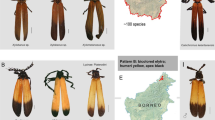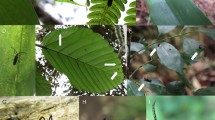Abstract
Although exceptional examples of adaptation are frequently celebrated, some outcomes of natural selection seem far from perfect. For example, many hoverflies (Diptera: Syrphidae) are harmless (Batesian1) mimics of stinging Hymenoptera2. However, although some hoverfly species are considered excellent mimics, other species bear only a superficial resemblance to their models3 and it is unclear why this is so. To evaluate hypotheses that have been put forward to explain interspecific variation in the mimetic fidelity of Palearctic Syrphidae we use a comparative approach. We show that the most plausible explanation is that predators impose less selection for mimetic fidelity on smaller hoverfly species because they are less profitable prey items. In particular, our findings, in combination with previous results, allow us to reject several key hypotheses for imperfect mimicry: first, human ratings of mimetic fidelity are positively correlated with both morphometric measures and avian rankings, indicating that variation in mimetic fidelity is not simply an illusion based on human perception4; second, no species of syrphid maps out in multidimensional space as being intermediate in appearance between several different hymenopteran model species, as the multimodel hypothesis5 requires; and third, we find no evidence for a negative relationship between mimetic fidelity and abundance, which calls into question the kin-selection6 hypothesis. By contrast, a strong positive relationship between mimetic fidelity and body size supports the relaxed-selection hypothesis7,8, suggesting that reduced predation pressure on less profitable prey species limits the selection for mimetic perfection.
This is a preview of subscription content, access via your institution
Access options
Subscribe to this journal
Receive 51 print issues and online access
$199.00 per year
only $3.90 per issue
Buy this article
- Purchase on Springer Link
- Instant access to full article PDF
Prices may be subject to local taxes which are calculated during checkout




Similar content being viewed by others
References
Bates, H. Contribution to an insect fauna of the Amazon Valley, Lepidoptera: Heliconidae. Trans. Linn. Soc. Lond. 23, 495–566 (1862)
Mostler, G. Observations on the question of wasp mimicry. Z. Morphol. Oekol. Tiere 29, 381–454 (1935)
Gilbert, F. in Insect Evolutionary Ecology (eds Fellowes, M. D. E., Holloway, G. J. & Rolff, J. ) 231–288 (CABI Publishing, 2005)
Cuthill, I. C. & Bennett, A. T. D. Mimicry and the eye of the beholder. Proc. R. Soc. Lond. B 253, 203–204 (1993)
Edmunds, M. Why are there good and poor mimics? Biol. J. Linn. Soc. 70, 459–466 (2000)
Johnstone, R. A. The evolution of inaccurate mimics. Nature 418, 524–526 (2002)
Duncan, C. J. & Sheppard, P. M. Sensory discrimination and its role in the evolution of Batesian mimicry. Behaviour 24, 269–282 (1965)
Sherratt, T. N. The evolution of imperfect mimicry. Behav. Ecol. 13, 821–826 (2002)
Ruxton, G. D., Sherratt, T. N. & Speed, M. P. Avoiding Attack: The Evolutionary Ecology of Crypsis, Warning Signals, and Mimicry (Oxford Univ. Press, 2004)
Vereecken, N. J. & Schiestl, F. P. The evolution of imperfect floral mimicry. Proc. Natl Acad. Sci. USA 105, 7484–7488 (2008)
Edmunds, M. Do Malaysian Myrmarachne associate with particular species of ant? Biol. J. Linn. Soc. 88, 645–653 (2006)
Dittrich, W., Gilbert, F., Green, P., McGregor, P. & Grewcock, D. Imperfect mimicry—a pigeon’s perspective. Proc. R. Soc. Lond. B 251, 195–200 (1993)
Chittka, L. & Osorio, D. Cognitive dimensions of predator responses to imperfect mimicry. PLoS Biol. 5, e339 (2007)
Holen, Ø. H. & Johnstone, R. A. The evolution of mimicry under constraints. Am. Nat. 164, 598–613 (2004)
Speed, M. P. & Ruxton, G. D. Imperfect Batesian mimicry and the conspicuousness costs of mimetic resemblance. Am. Nat. 176, E1–E14 (2004)
Bain, R. S., Rashed, A., Cowper, V. J., Gilbert, F. S. & Sherratt, T. N. The key mimetic features of hoverflies through avian eyes. Proc. R. Soc. B 274, 1949–1954 (2007)
Green, P. R. et al. Conditioning pigeons to discriminate naturally lit insect specimens. Behav. Processes 46, 97–102 (1999)
Iserbyt, A. et al. Frequency-dependent variation in mimetic fidelity in an intraspecific mimicry system. Proc. R. Soc. B 278, 3116–3122 (2011)
Sutherland, W. J. Do oystercatchers select the most profitable cockles? Anim. Behav. 30, 857–861 (1982)
Harper, G. R. & Pfennig, D. W. Mimicry on the edge: why do mimics vary in resemblance to their model in different parts of their geographical range? Proc. R. Soc. B 274, 1955–1961 (2007)
Marples, N. M. Do wild birds use size to distinguish palatable and unpalatable prey types? Anim. Behav. 46, 347–354 (1993)
Hagman, M. & Forsman, A. Correlated evolution of conspicuous coloration and body size in poison frogs (Dendrobatidae). Evolution 57, 2904–2910 (2003)
Janzen, D. H., Hallwachs, W. & Burns, J. M. A tropical horde of counterfeit predator eyes. Proc. Natl Acad. Sci. USA 107, 11659–11665 (2010)
Gilbert, F. S. & Owen, J. Size, shape, competition and community structure in hoverflies (Diptera: Syrphidae). J. Anim. Ecol. 59, 21–39 (1990)
Friendly, M. & Fox, J. Candisc: generalized canonical discriminant analysis. R package version 0. 5-19, 〈http://CRAN.R-project.org/package=candisc〉 (2010)
R Development Core Team. R: A Language and Environment for Statistical Computing (R Foundation for Statistical Computing, 2010)
Skevington, J. H. & Yeates, D. K. Phylogeny of the Syrphoidea (Diptera) inferred from mtDNA sequences and morphology with particular reference to classification of the Pipunculidae (Diptera). Mol. Phylogenet. Evol. 16, 212–224 (2000)
Ståhls, G., Hippa, H., Rotheray, G., Muona, J. & Gilbert, F. Phylogeny of Syrphidae (Diptera) inferred from combined analysis of molecular and morphological characters. Syst. Entomol. 28, 433–450 (2003)
Gibson, J. F., Skevington, J. H. & Kelso, S. Placement of the Conopidae (Diptera) within the Schizophora based on ten mtDNA and nrDNA gene regions. Mol. Phylogenet. Evol. 56, 91–103 (2010)
Ronquist, F. & Huelsenbeck, J. P. MrBayes 3: Bayesian phylogenetic inference under mixed models. Bioinformatics 19, 1572–1574 (2003)
Miller, M. A., Pfeiffer, W. & Schwartz, T. in Proceedings of the Gateway Computing Environments Workshop (GCE) (IEEE, 2010)
Nylander, J. A. A. MrModeltest v.2 (Evolutionary Biology Centre, Uppsala Univ., 2004)
Rotheray, G. & Gilbert, F. Phylogeny of Palaearctic Syrphidae (Diptera): evidence from larval stages. Zool. J. Linn. Soc. 127, 1–112 (1999)
Mengual, X., Ståhls, G. & Rojo, S. First phylogeny of predatory flower flies (Diptera, Syrphidae, Syrphinae) using mitochondrial COI and nuclear 28S rRNA genes: conflict and congruence with the current tribal classification. Cladistics 24, 543–562 (2008)
Paradis, E., Claude, J. & Strimmer, K. APE: analyses of phylogenetics and evolution in R language. Bioinformatics 20, 289–290 (2004)
Pinheiro, J., Bates, D., DebRoy, S. & Sarkar, D. R Development Core Team. nlme: linear and nonlinear mixed effects models. R package version 3. 1-98, 〈http://CRAN.R-project.org/package=nlme〉 (2011)
Fletcher, T. D. Psychometric: applied psychometric theory. R package version 2. 2, 〈http://CRAN.R-project.org/package=psychometric〉 (2010)
Acknowledgements
We thank W. Knee for help with the Bayesian analysis, and R. Laird, G. Ruxton and M. Speed for comments on the manuscript. The human aspect of this research was approved by the Carleton University Research Ethics Committee and conducted according to the guidelines set out in the Tri-Council Policy Statement on Ethical Conduct for Research Involving Humans; subjects gave informed consent. The work was supported by grants to T.N.S. from the Natural Sciences and Engineering Research Council of Canada (NSERC), the Canada Foundation for Innovation and the Ontario Innovation Trust, and to J.H.S. from Agriculture and Agri-Food Canada, the Canadian Centre for DNA Barcoding and NSERC Canpolin. C.H. was supported by an Ontario MRI Fellowship.
Author information
Authors and Affiliations
Contributions
H.D.P. photographed and measured specimens, and collected data on human rankings. J.H.S. provided the novel molecular phylogeny. C.H. analysed the data. C.H., K.R.A. and T.N.S. wrote the paper. T.N.S. conceived the project. All authors discussed the results and provided comments on the manuscript.
Corresponding author
Ethics declarations
Competing interests
The authors declare no competing financial interests.
Additional information
All newgenetic sequences are deposited inGenBank andare listed in Supplementary Table 4.
Supplementary information
Supplementary Information
This file contains Supplementary Figures 1-6, Supplementary Tables 1-4, a Supplementary Discussions and additional references. (PDF 5796 kb)
Rights and permissions
About this article
Cite this article
Penney, H., Hassall, C., Skevington, J. et al. A comparative analysis of the evolution of imperfect mimicry. Nature 483, 461–464 (2012). https://doi.org/10.1038/nature10961
Received:
Accepted:
Published:
Issue Date:
DOI: https://doi.org/10.1038/nature10961
This article is cited by
-
On the sparrowhawk-like calls of female common cuckoos: testing for heterospecific vocal mimicry in a conspecific functional context
Behavioral Ecology and Sociobiology (2023)
-
Body size in Batesian mimicry
Evolutionary Ecology (2023)
-
Do termitophilous beetles (Staphylinidae: Aleocharinae) resemble those they live with? Morphometrical and chromatic analysis points to a negative answer
Zoomorphology (2022)
-
Increased speed of movement reduced identification of Batesian ant-mimicking spiders by surrogate predators
Animal Cognition (2021)
-
Relationship between model noxiousness and mimetic accuracy in myrmecomorphic spiders
Evolutionary Ecology (2021)
Comments
By submitting a comment you agree to abide by our Terms and Community Guidelines. If you find something abusive or that does not comply with our terms or guidelines please flag it as inappropriate.



